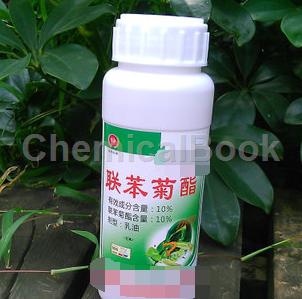Bifenthrin has contact killing and stomach poisoning effects on pests; but no systemic or fumigation effects; it has a broad insecticidal spectrum and rapid action; it does not move in the soil, is relatively safe for the environment, and has a long residual effect. It is suitable for cotton, fruit trees, vegetables, tea and other crops to control lepidopteran larvae, whiteflies, aphids, leaf miners, leafhoppers, spider mites and other pests and mites. It is especially used when pests and mites coexist, saving time and medicine.
How to use bifenthrin
1. For cotton, cotton spider mites and other mites and citrus leaf miner and other pests, during the egg hatching or full hatching period, and the adult and nymph mite occurrence period, use 1000-1500 times of the medicinal solution with a 16-liter manual sprayer Spray the plants finely.
2. For adults and nymphs such as aphids, whiteflies, and spider mites on vegetables such as cruciferous and cucurbitaceous vegetables, use a fine spray of 1000-1500 times the liquid.
3. For inchworms, small green leafhoppers, tea caterpillars, and black-thorned whiteflies on tea trees, use 1000-1500 times the chemical solution to spray finely during the 2-3 instar and nymph stages.
4. For registered crops that are not indicated on the product, small-scale trials must be carried out first, and the green parts of certain Cucurbitaceae crops must be tested to ensure that there is no phytotoxicity and good results can be achieved before promotion.

Precautions when using bifenthrin
1. This product is not registered for use on rice, but some local farmers have found that it is very effective in controlling rice leaf rollers when controlling tea pests. If farmers want to use this agent to control non-registered crop pests such as rice, especially in areas where rice and mulberry are mixed, silkworms are easily poisoned, so they must be cautious to prevent heavy losses from silkworm poisoning.
2. This product is highly toxic to fish, shrimps and bees. When using it, keep away from beekeeping areas and do not pour residual liquid into rivers, ponds and fish ponds.
3. Since frequent use of pyrethroid pesticides will cause pests to develop resistance, they should be used alternately with other pesticides to delay the development of resistance. They are intended to be used 1-2 times per crop season.
Crops suitable for bifenthrin
Bifenthrin is suitable for use on cotton, fruit trees, vegetables, tea and other crops to prevent and control lepidopteran larvae, whiteflies, aphids, leaf miners, leafhoppers, spider mites and other pests and mites. It is especially used when pests and mites coexist, saving time and medicine.
Can bifenthrin control corn heartworm?
Prevention and control methods of corn borer:
1. Prevention and Control Measures
Prevention and control should be done through four combinations, that is, the combination of overwintering control and field control; the combination of heart leaf stage control and ear stage control; the combination of chemical control and biological control;
The control of corn should be combined with the control of other host crops. Dispose of overwintering straw. In the winter and spring before adults emerge, corn stalks and cobs are treated using methods such as guillotine, rolling, retting, burning, and mud sealing to eliminate overwintering larvae. Choose insect-resistant varieties. Selecting and planting varieties with higher anti-borin content can effectively control the damage caused by corn borer to corn heart and leaves. Change planting times. Increasing the planting area of spring corn and reducing the planting area of summer corn can reduce the damage of corn borer.
2. Chemical prevention
1. Use 7-100 ml of 20% triazophos emulsifiable concentrate per mu, mix it into poisonous soil and apply it to the heart leaves; triazophos can also be sprayed with 500-800 times of liquid.
2. Use 100-150 grams of 50% fenitrocar wettable powder per mu mixed with 16-20 pounds of fine sand and apply it to the heart leaves, or fill or spray with 100 grams of fenitrocar diluted 1000 times, or use 90 % trichlorfon 1500-2000 times solution, or 80% dichlorvos EC 2500-3000 times solution, fill each plant with 10-15 ml.
3. Spray with 20% tebufenozide 1300-2300 times, which is highly effective and pollution-free.
4. Use pyrethroid insecticides such as 20% fenpropathrin 1000-2000 times solution, 2.5% lambda-cyhalothrin or deltamethrin 2000-4000 times solution, 40% fenvalerate Fill or spray with 4000 times solution of ester, or spray with 20% diflubenzuron 1000-2000 times solution. If diflubenzuron is mixed with pyrethroid insecticides, it can speed up the killing of insects and also control aphids. At the same time, to prevent the development of drug resistance, medications must be rotated.
Note: Bifenthrin + imidacloprid or acetamiprid and pymetrozine can be sprayed together to control pests such as corn borers, aphids, armyworms, cotton bollworms, and corn spider mites at the same time.

 微信扫一扫打赏
微信扫一扫打赏

